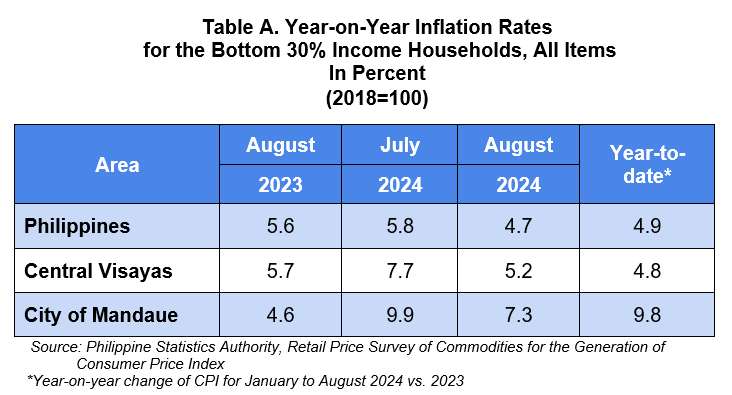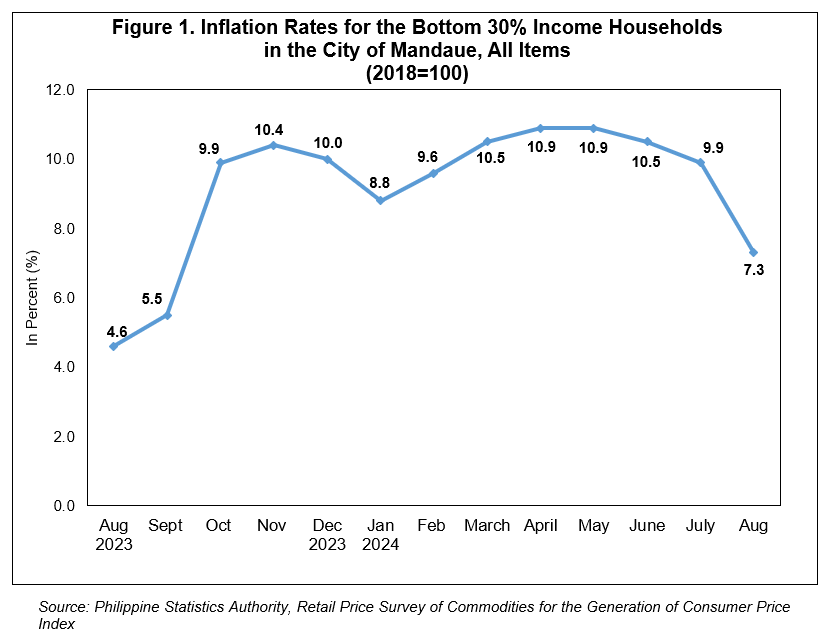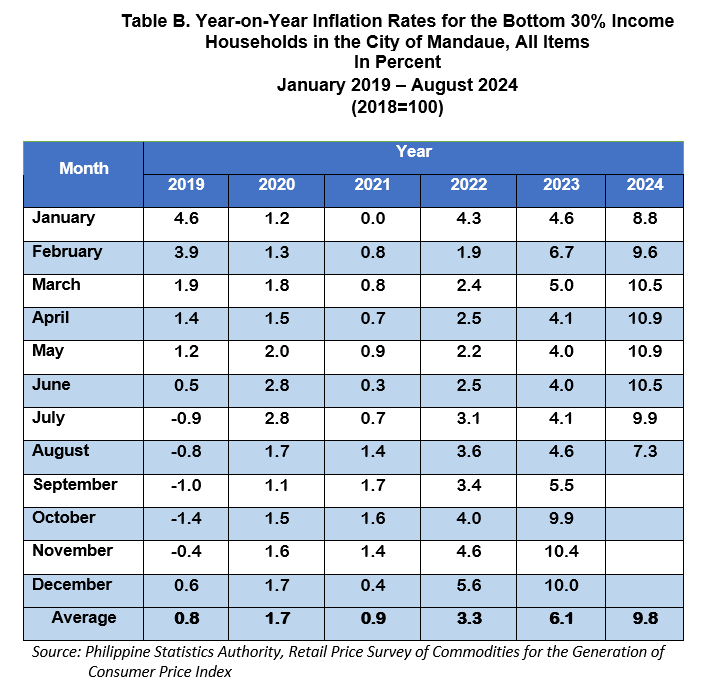

A. The Philippines
The country’s inflation rate for the bottom 30% income households slowed down to 4.7 percent in August 2024 from 5.8 percent in July 2024. This brings the average inflation from January to August 2024 for this income group to 4.9 percent. In August 2023, inflation rate was posted at 5.6 percent. (Table A)
B. Central Visayas
1. Regional Inflation
Following the trend at the national level, inflation rate for the bottom 30% income households in Central Visayas eased to 5.2 percent in August 2024 from 7.7 percent in August 2024. The region’s average inflation for this income group from January to August 2024 stood at 4.8 percent. In August 2023, the inflation rate in the region recorded at 5.7 percent. (Table A)
C. City of Mandaue
1. Headline Inflation
The headline inflation rate for the bottom 30% income households in the City of Mandaue had a slower increase at 7.3 percent in August 2024 from 9.9 percent in July 2024. This brings the city’s average inflation at 9.8 percent from January to August 2024. In August 2023, the inflation rate was lower which recorded at 4.6 percent. (Table A and Figure 1)
1.1 Main Drivers to the Downward Trend of Headline Inflation in the City of Mandaue
The main drivers to the deceleration of the headline inflation rate during the month were mainly brought by the slower year-on-year increases of food and non-alcoholic beverages at 3.7 percent, transport at 1.2 percent, and housing, water, electricity, gas and other fuels at 31.0 percent from their respective inflation rates at 8.4 percent, 3.6 percent and 31.5 percent in July 2024.
Slower annual increments were also observed in the indices of health at 4.3 percent and alcoholic beverages and tobacco at 0.4 percent in August 2024 from their previous month’s respective inflation rates at 4.6 percent and 0.5 percent.
In contrast, faster annual increase was posted in the index of personal care, and miscellaneous goods and services at 3.9 percent in August from 3.8 percent in July 2024.
Moreover, the indices of commodity groups that retained their previous month’s inflation were as follows:
a. Clothing and footwear, 0.9 percent;
b. Furnishing, household equipment and routine household maintenance, 3.7 percent;
c. Information and communication, 0.0 percent;
d. Recreation, sport and culture, 22.5 percent;
e. Education services, 0.0 percent;
f. Restaurants and accommodation services, 0.9 percent; and
g. Financial services, 0.0 percent. (Table 3)
1.2 Main Contributors to the Headline Inflation
The following commodity groups were the top three contributors to the August 2024 overall inflation for the bottom 30% income households in the City of Mandaue:
a) Housing, water, electricity, gas and other fuels with 67.8 percent share or 5.0 percentage points.
b) Food and non-alcoholic beverages with 23.7 percent share or 1.7 percentage points; and
c) Recreation, sport and culture with 2.4 percent share or 0.2 percentage point.
2. Food Inflation
Food inflation rate for the bottom 30% income households in the City of Mandaue had a slower increase at 3.9 percent in August from 9.0 percent in July 2024. In August 2023, the food inflation stood at 6.5 percent. (Table 7)
2.1 Main Drivers to the Downtrend of Food Inflation
The downtrend in the food inflation in August 2024 was primarily driven by the slower annual increase in the indices of rice at 9.3 percent, corn at 14.1 percent and vegetables, tubers, plantains, cooking bananas and pulses at 9.2 percent from their previous month’s respective inflation rates at 19.6 percent, 35.4 percent and 27.3 percent. Also contributing to the downtrend of the food inflation was the faster year-on-year decrease of fish and other seafood at 9.8 percent in August 2024 from 9.2 percent annual decline in July 2024. (Table 5)
In addition, lower inflation rates were observed in the following food groups during the month:
a. Ready-made food and other food products not elsewhere classified, 6.9 percent from 8.8 percent;
b. Meat and other parts of slaughtered land animals, 4.7 percent from 4.9 percent; and
c. Sugar, confectionary and desserts, -7.0 percent from -5.9 percent. (Table 5)
In contrast, the following food groups registered higher inflation rates during the month:
a. Flour, bread and other bakery products, pasta products, and other cereals, 1.3 percent from 1.1 percent;
b. Milk, other dairy products and eggs, -0.7 percent from -2.4 percent; and
c. Fruits and nuts, 13.5 percent from 11.6 percent. (Table 5)
Meanwhile, no price movement in oils and fats index. (Table 5)
2.2 Main Contributors to the Food Inflation
Food inflation contributed 23.0 percent share or 1.7 percentage points to the August 2024 overall inflation for this particular income group.
Among the food groups, the main contributors to the food inflation during the month were the following:
a. Cereals and cereal products, which includes rice, corn, flour, bread and other bakery products, pasta products, and other cereals, with 97.2 percent share or 3.8 percentage points;
b. Meat and other parts of slaughtered land animals with 16.3 percent share or 0.6 percentage point; and
c. Vegetables, tubers, plantains, cooking bananas and pulses with 11.3 percent share or 0.4 percentage points.

TECHNICAL NOTES
The Philippine Statistics Authority generates and announces the monthly Consumer Price Index (CPI) based on a nationwide survey of prices for a given basket of goods and services. Two important indicators, the inflation rate and purchasing power of the peso (PPP), are derived from the CPI which are important in monitoring price stability and the value of the country’s currency.
The CPI is an indicator of the change in the average retail prices of a fixed basket of goods and services commonly purchased by households relative to a base year.
Retail Price is the price at which a commodity is sold for spot in small quantities for consumption.
Base Period/Base Year is the period, usually a year, at which the index number is set to 100. It is the reference point of the index number series.
Market Basket is a term used to refer to a sample of goods and services that are commonly purchased and bought by an average Filipino household.
Weight is a value attached to a commodity or ground of commodities to indicate the relative importance of that commodity or group of commodities in the market basket.
Inflation Rate is equivalent to a decline in the purchasing power of the peso. It is the change in the CPI over a specific period of time (usually a month or a year). That is,

where:
CPI1 - is the CPI in the previous period
CPI2 - is the CPI in the current period
The Purchasing Power of the Peso (PPP) is a measure of the real value of the peso in a given period relative to a chosen reference period. It is computed by getting the reciprocal of the CPI and multiplying the result by 100. That is,

Headline Inflation is the rate of change in the weighted average prices of all goods and services in the CPI basket.
Approved by:
MELCHOR B. BAUTISTA
Chief Statistical Specialist
MLA/KST/MJDG

